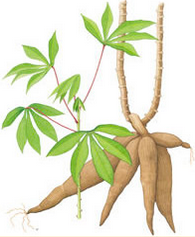This online guide has
been created for you to successfully grow a variety of
plants that thrive in the tropics, using native seeds
and plants to get growing with wise advice from fellow
backyard gardeners and farmers. You are welcome to add
your wisdom, share seed procurement, growing, harvest
tips and recipes. Send to proorganicbelize@gmail.co
Welcome to Pro-Organic
Belize
Tropical Garden Grow
Guide
Where you are the
student and the teacher
May 2023 Plant of the month

| Botanic name: | (Manihot esculenta) |
| Plant type: | A root vegetable that grows well in
tropical climates. |
| Sun exposure: | Full to partial sun |
| Soil pH: | 4.5 – 6.5 |
| Soil preference: | Moist, but not wet, sandy and loamy
soil. |
CASSAVA
(credit: International Institute of Tropical Agriculture)
To help ensure food security and boost nutrition, every backyard garden should contain a section of easy to grow cassava. Cassava is an ornamental plant with many benefits.Description: A plant that produces edible large palmate leaves and underground edible strarchy tubers. Cassava typically grows to be between 5'-8' in height and approximately 4' in diameter. There are 2 common varieties; bitter and sweet. The sweet variety is far more popular.
How to grow: Start plants with 5” - 10” pieces of stem cut close to the stem post harvest. Make sure at least 3 or more knobby buds are visible on each stem. Cultivate the soil to loosen, create a shallow trench about 3”- 4” deep then lay two cassava stem pieces side by side about 3” - 4” apart, cover with soil, then water throughly. Keep soil moist, but not soggy and well weeded until plants grow taller than the surrounding weeds. Some farmers and garden resources recommend planting only one stem in each trench. Others advise planting just the bottom half ot two stems crossed. This method is easier, but less productive. In any case allow about 2.5' - 3' between plantings.
Disease and insect
control: Cassava is resistant to most plant pests
as the plant contains hydrocyanic glycosides. White
flies and other insects may be controlled by placing
large sheets of stiff poster board coated with oil close
to plants. Ground moles and wee wee ants are fond of
cassava. Moles
may be deterred by neem oil and hot pepper spray.
How to harvest: Check
plants about 8 months post planting. Most varieties
of cassava ripen in approximately 9-12 months. There are some
varieties that are ready for harvest in 5-6 months,
check these varieties 5 months post planting. Uproot one
plant to check that tubers are at least 4” long. Tubers
typically grow to be between 8” - 15” long and from 1” -
4” in dismeter. Once the tubers are harvested they must
be used within 2-3 days post harvest. Tubers may be
covered with water and refrigerated to extend their
viability by a few days.
Black lines running through the harvested cassava
indicates spoilage.
Health benefits: Cassava
tubers contains vitamin A, phosophorous, calcium and
riboflavin. They
are a good source of fiber and helps to prevent
constipation. The
leaves are high in protein and contain vitamin C, some B
vitamins and beta carotene. Cassava peels
have medicinal properties to help promote healing of
injuries.
IN ORDER TO MAKE
CASSAVA SAFE FOR HUMAN CONSUMPTION, THE TUBERS AND
LEAVES MUST BE THROUGHLY COOKED. COOKING
REMOVES CYANIDE FROM THE ROOTS AND LEAVES.
Here is a simple
effective way to process cassava to remove cyanide. Peel each
tuber removing the outer peel and the inner pinkish
peel. Wash
each tuber, then cut the tubers into pieces about 4” to
6” long. Place
in a large pot cover with water cover and boil over a
low heat for at least 60 minutes, Drain the cooking
water then allow the pieces to cool. Once the
pieces are cool, cut each one in half vertically remove
the stringy cord from the center and discard. Cassava
leaves must also be boiled prior to eating them.
A simple basic
cassava recipe: Follow the directions above to
cook then cool the cassava pieces and cut into 'sticks'
about ½ to ¾ “ wide. Heat coconut oil in a skillet to a
low to medium heat then add the cassava pieces turning
gently after about 2 minutes cook for another 2 minutes,
then sprinkle with salt and pepper and serve. Cooked cassava
pieces may be added to soups or made into desserts.
Deborah Harder's book: 'Fruits,
Roots and Shoots: Using Tropical Plants for Self
Sufficiency' contains a helpful guide to growing
cassava with many recipes and guides to using cassava.
Sabals Cassava Farm, a
family owned and operated farm, is located on Valley
Road in Stann Creek.
They have many cassava products for sale and
operate tours about the process of growing, harvesting
and enjoying cassava while honoring and celebrating
Garifuna culture.
Did you know that
tapioca is made from cassava?